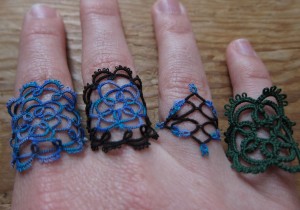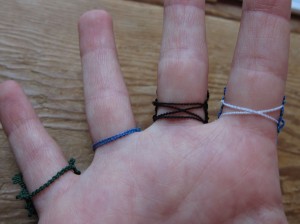From size 3 to size 120
 During the Shuttlebirds’ conference last month I broke down and picked up a couple spools of King Tut quilting thread from Debbie Arnold of DS9 Designs. I say that I broke down because I was really resisting buying more thread during the conference (though I managed to spend all my money on shuttles instead) and with my tendency to want to work on really large projects I really don’t need to start thinking about quilting thread (Debbie says it’s the equivalent to size 120.), but the colors are just so pretty that I couldn’t resist a couple just to try it out.
During the Shuttlebirds’ conference last month I broke down and picked up a couple spools of King Tut quilting thread from Debbie Arnold of DS9 Designs. I say that I broke down because I was really resisting buying more thread during the conference (though I managed to spend all my money on shuttles instead) and with my tendency to want to work on really large projects I really don’t need to start thinking about quilting thread (Debbie says it’s the equivalent to size 120.), but the colors are just so pretty that I couldn’t resist a couple just to try it out.
I made the motif of the one on the left first just to try out using thread this small and see how the variegate would work out. The pattern is the same motif from the star doily (at some point I’m going to actually finish that). I finished the motif and had it sitting on my hand and realized it would make an awesome ring. I worked up the green one on the right to mess around with trying out a band. (It’s the center part of the motif in size 20 thread.)
Note: I wouldn’t do it again in size 20 thread because (as you can see) it doesn’t lay flat nicely (though this might be because of the very scalloped edging), but I just wanted something that would work up quickly so I could try it out. I’ll have to try sizes 40 and 80 sometime to see how they work. I think 80 would be good for most patterns. 40 might depend on the edges.
The bands are just lock-chains from one side to the other. (Note that the picture is flipped from the one above.) The first two I made just a single band and then played around with criss-crossing them. I like the black one on my middle finger the best. Each time it’s attached to the motif it’s done with a join so I think that it one band were to break the others would stay put ok. It’d have to be fixed, but at least the ring wouldn’t be lost. That being said, the chains are pretty strong so I think they will be ok.
If I don’t get distracted I’ll probably make a bunch more of these. In all of these samples I made the motifs separate from bands, largely because I wanted the bands to start a places where it wasn’t convenient to end tatting the motif. I think it’s a good way to do it for now. At least until I’ve done a bit of product testing and seen how strong the chains are in this size thread. If a band breaks, I can just make another.
One thing I haven’t figured out yet is how to hide the ends with this size thread. I’ve recently gotten into the habit of sewing in my ends rather than using the magic thread technique and I tried doing that with the first motif, but it was really difficult to make it work and it turned in to a (literal) bloody mess. It’s hard to get the needle in between the stitches and managed to instead to split the thread and fray it in the process.
For the last two rings I just tied off the thread and cut it so hopefully they don’t come apart. I’ll try the magic thread trick next, but looking for other suggestions. I think I was using a size 26 (might have been 22) tapestry needle. Are sewing needles smaller? I feel like with a smaller needle I just might be likely to fray the thread more.
Edit: One thing I’ve noticed after wearing it for a couple days is that it does stretch some. The lock chain is pretty stretchy (that’s why I picked it) but I wonder if a spiral chain might have been better.  Just be aware that if you make one you need to make it really tight. The next one I make I might try making it for smaller finger and wearing it on that one for a while before switching it to the finger I actually want it for.


Ai Said,
May 27, 2011 @ 11:34 am
I have size 28 tapestry needles for sewing ends in; I don’t think I’ve seen smaller than that (I probably would have tried to pick some of up if I did). I don’t recall having any particular problems sewing the ends in for size 80 thread, but I haven’t tried any smaller thread (or, I didn’t need to weave the ends in because I was attaching it to something else). I don’t think a size 22 needle with 120 thread would work very well; a size 26 needle might still be a bit large (given that I picked up size 28 needles because I think I found my 24’s too large for size 80 thread).
If I were tying off the ends I’d probably dab a bit of fray check (or the equivalent) on the knot. It dries hard kind of and scratchy, so maybe not so good for the inside of a ring.
I’d probably try the magic thread method, but I remember having problems with some size of thread. Having the knots large enough to pull a doubled over thread through meant that the knots seemed extra large and slightly loose afterward; I think it was more noticeable in the smaller thread sizes or something.
Maybe you could make the knots slightly looser where you’re planning to sew the ends in? I haven’t tried that, but it seems like it should help with being able to get a needle wiggled between the threads. Hmm, I should give that a try sometime.
admin Said,
May 28, 2011 @ 2:00 am
I stopped by Michaels today and got some size 28 needles. We’ll see how that works. Looking at the needles today in the store I’m guessing that what I was using before must have been size 26. It was just small enough to make me think that maybe it would work, but just large enough to not actually work. I’ve had really bad luck with the magic thread method for size 80 thread, so I’m going to keep trying to find a way to sew in the ends. If I pay attention to the last few stitches and try to make them just loose enough to get the needle through maybe it will work.
Barbara Gordon Said,
May 28, 2011 @ 6:23 am
I have quite a bit of King Tut thread now, so I’ll have to try some rings to. Looks really neat….my fingers are so skinny, I don’t know if it will work for me…
admin Said,
May 28, 2011 @ 7:34 am
Hi Barbara,
It should still work fine, you just might have to use a smaller motif. The one on my ring finger is pretty small, and just using the center part of the motif on the others would work fine.